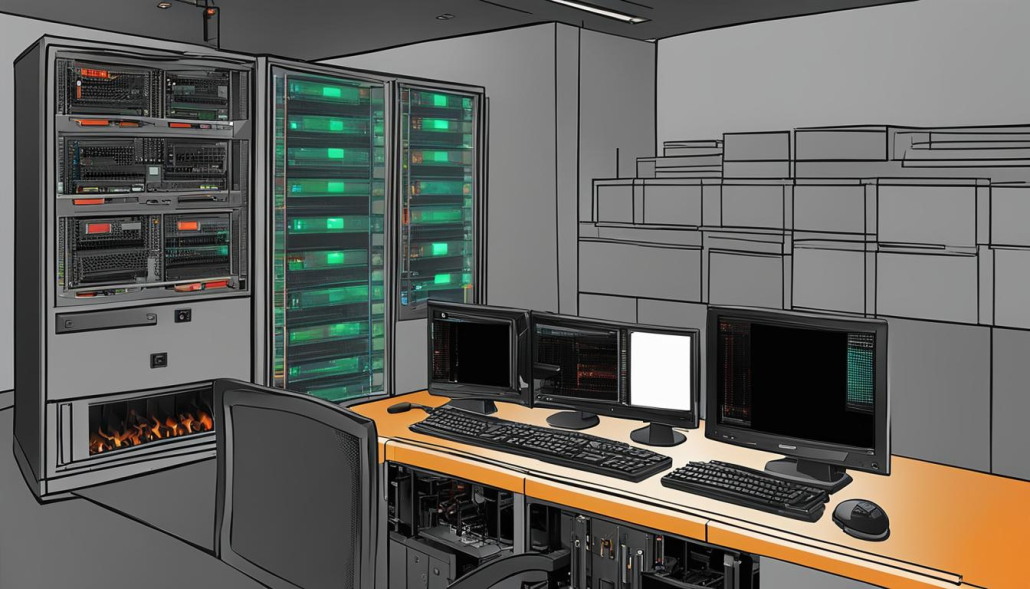Understanding Firewalls: What is a Firewall for Your Security?
A firewall is a computer network security system that restricts internet traffic in, out, or within a private network. It acts as a barrier to unauthorized web activities and helps prevent malicious activity. Firewalls can be thought of as gated borders that manage the flow of web traffic in a private network. They create “choke points” where traffic is reviewed and filtered based on programmed parameters. There are different types of firewalls, including hardware and software-based ones. Hardware firewalls are physical devices positioned between a computer and the internet, while software firewalls are built-in features or separate software programs. Firewalls are an essential component of network security, working alongside other protective measures like antivirus software to strengthen resistance against attacks.
Key Takeaways:
- A firewall is a computer network security system that controls internet traffic.
- It acts as a barrier to unauthorized activities and helps prevent malicious activity.
- Firewalls can be hardware or software-based.
- They are an essential component of network security, working alongside other protective measures like antivirus software.
- Firewalls help strengthen resistance against attacks and protect private networks.
What do Firewalls Do?
Firewalls are a vital component of network security, providing protection against outside cyber attackers by shielding a computer or network from malicious or unnecessary network traffic. They act as guardians, blocking data from certain locations, applications, or ports while allowing relevant and necessary data through. Firewalls also play a crucial role in preventing malicious software from accessing a network via the internet.
Firewalls offer a range of features that enhance network security. These include:
- Network threat prevention: Firewalls can identify and block potential threats, such as suspicious IP addresses or known attack patterns.
- Application and identity-based control: Firewalls can enforce policies based on specific applications or user identities, allowing organizations to have granular control over network access.
- Hybrid cloud support: Firewalls can protect both on-premises and cloud-based environments, ensuring consistent security across different platforms.
- Scalable performance: Firewalls are designed to handle high volumes of network traffic without compromising performance.
By leveraging these features, firewalls help safeguard networks against various types of cyber threats, providing organizations with a crucial layer of defense.
Types of Firewalls
In the world of network security, different types of firewalls are deployed to protect networks from unauthorized access and malicious activity. Let’s explore some common types of firewalls and how they are implemented.
1. Packet Filtering Firewalls
Packet filtering firewalls analyze data packets based on predefined filter standards, such as source and destination IP addresses, ports, and protocols. They make decisions about allowing or blocking packets based on these filters. Packet filtering firewalls are relatively simple and efficient, but they provide limited visibility into application-layer traffic.
2. Proxy Service Firewalls
Proxy service firewalls act as intermediaries between clients and servers. They filter messages at the application layer and provide additional security features such as user authentication and content filtering. Proxy firewalls can enhance network security by inspecting and filtering both inbound and outbound traffic.
3. Stateful Inspection Firewalls
Stateful inspection firewalls combine the benefits of packet filtering and proxy service firewalls. They monitor active connections and use dynamic packet filtering to determine which network packets should be allowed through. Stateful inspection firewalls maintain information about the state of network connections, enabling them to make more informed decisions about packet filtering.
4. Next-Generation Firewalls (NGFW)
Next-generation firewalls (NGFW) provide advanced features beyond traditional firewalls. They offer deep packet inspection, application-level inspection, and the ability to identify specific applications for security policy enforcement. NGFWs integrate multiple security technologies, such as intrusion prevention systems (IPS) and antivirus, into a single solution.
Firewalls can be implemented through dedicated hardware appliances, software installations, or virtual appliances depending on the network setup and requirements.
Please accept YouTube cookies to play this video. By accepting you will be accessing content from YouTube, a service provided by an external third party.
If you accept this notice, your choice will be saved and the page will refresh.
Summary:
In summary, firewalls are essential components of network security. They come in various types, including packet filtering, proxy service, stateful inspection, and next-generation firewalls. Each type has its own strengths and implementation methods. It’s important to choose the appropriate type of firewall based on your network’s requirements and security needs.
The Importance of Firewalls
Firewalls are a critical component of network security, providing an essential layer of defense against unauthorized access and malicious activity. By acting as a barrier, firewalls filter and control the flow of internet traffic, allowing only authorized connections and blocking potential threats. The importance of firewalls lies in their ability to protect sensitive data, ensure network integrity, and safeguard against cyber attacks.
One of the key benefits of firewalls is their ability to detect and block malware and application-layer attacks. By analyzing incoming and outgoing traffic, firewalls can identify and prevent malicious software from accessing a network. This helps to protect against data breaches, unauthorized data exfiltration, and the infiltration of harmful programs.
Firewalls also provide additional functionalities such as network address translation (NAT) and virtual private network (VPN) support. NAT allows organizations to hide internal IP addresses, making it more challenging for attackers to target specific network hosts. VPNs provide a secure way to transmit data across shared or public networks, ensuring that sensitive information remains protected.
Firewalls are an integral part of network security, working alongside other protective measures like antivirus software to strengthen resistance against attacks.
| Firewall Benefits | Explanation |
|---|---|
| Data protection | Firewalls help safeguard sensitive data by preventing unauthorized access and blocking malicious traffic. |
| Network integrity | By controlling traffic flow, firewalls ensure the integrity and reliability of a network, minimizing the risk of unauthorized modifications or disruptions. |
| Threat prevention | Firewalls play a crucial role in detecting and preventing malware, application-layer attacks, and other cybersecurity threats. |
| Secure remote access | With the support of VPN functionality, firewalls enable secure remote access to networks, allowing authorized users to connect from external locations. |
In summary, firewalls are of paramount importance in ensuring network security. They provide a vital layer of defense against unauthorized access and malicious activity, helping to protect sensitive data and maintain the integrity of a network. By leveraging the benefits of firewalls, organizations can enhance their overall security posture and mitigate the risks associated with evolving cyber threats.
History of Firewalls
Firewalls have a rich history that dates back to the late 1980s and has since evolved as technology advanced. Over the years, different generations of firewalls have emerged to address specific challenges in network security.
In the early days, firewalls were primarily packet filters. These filters examined data packets transferred between computers and analyzed them based on predefined filter standards. However, as technology progressed and cyber threats became more sophisticated, firewalls needed to adapt.
The second generation of firewalls focused on protecting against attacks from the internet. This led to the development of firewalls as a protective measure, shielding computers and networks from unauthorized access and malicious activity.
Subsequent generations of firewalls addressed vulnerabilities in applications, paved the way for intrusion prevention systems (IPS), and introduced advanced threat prevention solutions to combat large-scale, multi-vector attacks. Today, firewalls continue to evolve to keep up with the ever-changing cybersecurity landscape.
| Generation | Main Focus | Key Innovations |
|---|---|---|
| 1 | Virus attacks on standalone PCs | Development of antivirus products |
| 2 | Attacks from the internet | Introduction of firewalls as a protective measure |
| 3 | Vulnerabilities in applications | Intrusion prevention systems (IPS) |
| 4 | Targeted, unknown, and evasive attacks | Anti-bot and sandboxing products |
| 5 | Large-scale, multi-vector, advanced attacks | Advanced threat prevention solutions |
As the cybersecurity landscape continues to evolve, firewalls will play a vital role in safeguarding networks and protecting against ever-evolving threats. Their history and evolution serve as a testament to the ongoing efforts to enhance network security and strengthen defenses against malicious cyber activities.
How Does a Firewall Work?
A firewall operates by selectively allowing or blocking data packets based on predefined rules. It filters traffic between different networks, preventing unauthorized access and malicious activity. Firewalls can work at the network layer or the application layer.
Network layer firewalls inspect packets at a relatively low level of the TCP/IP protocol stack, filtering based on IP addresses and ports. They focus on source and destination filtering, blocking or allowing traffic based on specific IP addresses or ranges, and port numbers. This type of firewall is effective for basic security and is commonly used in small-scale networks.
Application layer firewalls, on the other hand, dive deeper into web traffic, filtering based on specific protocols like HTTP. They provide content management by examining data packets at the application layer, allowing or blocking traffic based on the content of the packets. Application layer firewalls provide more granular control over network traffic, enabling organizations to define specific rules for different applications and protocols.
Firewalls use a combination of techniques to determine whether traffic should be allowed or blocked. These techniques include source and destination filtering, packet and application protocol inspection, and rule-based control. By analyzing these factors, firewalls ensure that only legitimate and safe traffic passes through, while blocking potentially harmful traffic.
Network Layer vs. Application Layer Inspection
When it comes to network layer vs. application layer inspection, there are trade-offs to consider. Network layer firewalls offer faster processing speeds and are more suitable for large-scale networks with high volumes of traffic. They rely on IP addresses and ports, making them efficient for basic traffic filtering.
Application layer firewalls, on the other hand, provide a higher level of security and control. They are capable of inspecting the content of data packets, allowing administrators to define specific rules for different applications and protocols. However, this deeper level of inspection can result in slower processing speeds, especially in networks with high traffic volumes.
Summary
In summary, firewalls work by selectively allowing or blocking data packets based on predefined rules. They operate at either the network layer or the application layer, with each offering its own advantages and trade-offs. Network layer firewalls filter traffic based on IP addresses and ports, providing faster processing speeds but less granular control. Application layer firewalls dive deeper into web traffic, inspecting specific protocols and allowing for more precise rule-setting. By implementing firewalls, organizations can enhance their network security and protect against unauthorized access and malicious activity.
Firewall Inventors
Over the years, the invention and evolution of firewalls have involved multiple contributors who have played key roles in shaping firewalls into the essential security tools they are today. In the late 1980s, researchers at Digital Equipment Corp (DEC) developed packet-filtering technology that laid the foundation for future firewalls. Additionally, researchers at AT&T Bell Labs in the late 80s to early 90s worked on circuit-level gateways, which influenced the development of firewalls.
In the early 1990s, inventors at DEC and Check Point made significant contributions to firewall technology. Notable inventors in the firewall industry include Brian Reid, who worked on packet-filtering technology, and Paul Vixie, who made contributions to DNS and founded the Internet Software Consortium. Other influential inventors include Jeff Mogul, David Presotto, Janardan Sharma, Kshitiji Nigam, William Cheswick, Steven Bellovin, Marcus Ranum, Gil Shwed, and Nir Zuk.
These inventors have collectively contributed to the continuous improvement of firewalls, ensuring that they remain effective in protecting networks and data from ever-evolving cyber threats.
The Firewall’s Role in Network Security
Firewalls play a critical role in ensuring network security and protecting against unauthorized access and malicious activities. By serving as a barrier, firewalls regulate the flow of network traffic, allowing only authorized connections while filtering out potentially harmful traffic. Their importance in network security cannot be overstated, as they help safeguard sensitive data and prevent cyber threats from infiltrating private networks.
Firewalls act as gatekeepers, separating external public networks from internal private networks. They carefully inspect inbound and outbound traffic, analyzing factors such as source and destination IP addresses, ports, packet protocols, and application protocols. By applying predefined rules, firewalls determine which connections are allowed and which are denied, effectively filtering out potential security risks.
Furthermore, firewalls enhance network security by enabling user access control and network segmentation. They create subnets or segmented networks, which provide different levels of security and privacy. By segmenting the network, firewalls limit unauthorized access and mitigate the potential impact of a security breach by containing it to a specific network segment.
| Firewall’s Role in Network Security |
|---|
| Regulates network traffic |
| Filters out potentially harmful traffic |
| Safeguards sensitive data |
| Prevents unauthorized access |
| Inspects inbound and outbound traffic |
| Defines access control |
| Enables network segmentation |
When combined with other security measures like antivirus software and safe computing practices, firewalls further strengthen network security. They provide organizations with an essential layer of defense against cyber threats and help maintain the integrity and confidentiality of their networks.
As the cybersecurity landscape continues to evolve, firewalls will remain a fundamental component of organizations’ security strategies. They will adapt to address emerging threats and incorporate advanced technologies to detect and prevent new forms of cyberattacks. The firewall’s role in network security is crucial, ensuring that private networks are protected from unauthorized access and potential security breaches.
Filtering and Network Segmentation with Firewalls
Firewalls play a crucial role in network security by providing filtering capabilities and enabling network segmentation. With filtering, firewalls apply predefined rules to determine which connections are allowed and which are denied, ensuring that only legitimate and safe traffic passes through. This helps to block potentially harmful traffic, such as malware and unauthorized access attempts. By implementing effective filtering mechanisms, organizations can enhance their overall security posture and protect sensitive data.
Network segmentation, on the other hand, involves dividing a network into smaller subnets or segmented networks. Firewalls are an essential tool in creating and managing these segments, which provide different levels of security for various parts of the network. By separating external public networks, internal private networks, and perimeter networks, firewalls help establish barriers that prevent unauthorized access and limit potential damage in the event of a security breach.
Firewalls facilitate both inward and outward filtering, allowing organizations to define granular rules based on source and destination IP addresses, ports, packet protocols, and application protocols. This level of control enables the fine-tuning of network security policies, ensuring that only necessary and trusted connections are permitted while blocking potentially malicious or suspicious activities. Additionally, firewalls can help in preventing data exfiltration by restricting outbound connections, protecting sensitive information from unauthorized transmission.
Network segmentation and filtering with firewalls provide a layered approach to network security, reducing the attack surface and minimizing the impact of potential security incidents. By implementing these security measures, organizations can enhance their overall network defense, safeguard critical assets, and maintain a secure environment for their users and data.
Table: Benefits of Filtering and Network Segmentation with Firewalls
| Benefit | Description |
|---|---|
| Enhanced Security | Filtering and network segmentation with firewalls help strengthen the overall security posture, preventing unauthorized access and minimizing potential damage from security breaches. |
| Granular Access Control | Firewalls allow organizations to define specific rules and policies for network traffic, enabling granular access control based on source and destination addresses, ports, and protocols. |
| Reduced Attack Surface | Network segmentation divides the network into smaller, isolated segments, reducing the attack surface and limiting the impact of potential security incidents. |
| Data Protection | Filtering outbound connections with firewalls helps prevent data exfiltration, ensuring that sensitive information remains within the network and is not transmitted to unauthorized destinations. |
| Compliance Requirements | Segmenting networks and implementing filtering controls can help organizations meet specific compliance requirements, such as those outlined in industry standards and regulations. |
Next Generation Firewalls and Beyond
As the cybersecurity landscape continues to evolve, next generation firewalls (NGFWs) have emerged as a vital tool in protecting networks against advanced threats. NGFWs go beyond traditional packet filtering, incorporating features like deep packet inspection and application-level inspection. These advanced capabilities enable NGFWs to identify specific applications for security policy enforcement, providing a higher level of protection against sophisticated attacks.
One of the key advantages of NGFWs is their ability to integrate threat prevention technologies such as intrusion prevention systems (IPS) and antivirus. By combining multiple layers of defense, NGFWs can detect and prevent malware and other threats in real-time. This proactive approach to network security helps organizations stay one step ahead of potential attackers.
“NGFWs are crucial for securing data centers, networks, and cloud environments.”
The future of firewalls is likely to see further advancements in threat detection and mitigation techniques. As cyber threats become more sophisticated, firewalls will need to evolve to keep pace. Technologies such as sandboxing, which allows for the safe execution of potentially malicious code, may become more prevalent in future firewall solutions. Additionally, increased integration with other security tools and platforms will enhance overall network defense.
| Advantages of Next Generation Firewalls | Future Trends in Firewall Technology |
|---|---|
|
|
As organizations continue to rely on interconnected systems and data-driven technologies, the need for robust network security becomes increasingly important. Next generation firewalls offer a comprehensive solution that combines advanced threat prevention with deep visibility into network traffic. By staying up-to-date with emerging firewall technologies and implementing NGFWs, organizations can enhance their cybersecurity posture and protect their critical assets from ever-evolving threats.
Conclusion
Firewalls are integral to network security, acting as a barrier against unauthorized access and protecting against malicious activity. By filtering web traffic, firewalls play a crucial role in blocking potential threats and allowing only safe connections. With the evolution of cybersecurity, firewalls have adapted to address specific challenges, resulting in various types and generations of firewalls.
There are different types of firewalls, including hardware and software-based solutions. Hardware firewalls are physical devices that position themselves between a computer and the internet, while software firewalls can be built-in features or separate software programs. Firewalls work hand-in-hand with other security measures like antivirus software to strengthen network defenses.
As the cybersecurity landscape continues to evolve, firewalls will remain an essential component of organizations’ security strategies. They will continue to safeguard critical data and protect against ever-evolving threats. Whether it’s packet filtering, deep packet inspection, or next-generation firewalls, these security tools help maintain the integrity and confidentiality of networks, ensuring a safe digital environment.
FAQ
What is a firewall?
A firewall is a computer network security system that restricts internet traffic in, out, or within a private network. It acts as a barrier to unauthorized web activities and helps prevent malicious activity.
What do firewalls do?
Firewalls provide protection against outside cyber attackers by shielding a computer or network from malicious or unnecessary network traffic. They can block data from certain locations, applications, or ports while allowing relevant and necessary data through.
What are the types of firewalls?
There are several types of firewalls, including packet filtering, proxy service, stateful inspection, and next-generation firewalls (NGFW). Each type has its own way of filtering and protecting network traffic.
Why are firewalls important?
Firewalls are an integral part of network security, working alongside other protective measures like antivirus software to strengthen resistance against attacks. They help detect and combat attacks, safeguarding against various types of cyber threats.
What is the history of firewalls?
Firewalls have been in existence since the late 1980s and have evolved over time as technology advanced. Different generations of firewalls have addressed specific challenges in cybersecurity.
How does a firewall work?
A firewall operates by selectively allowing or blocking data packets based on predefined rules. It filters traffic between different networks, preventing unauthorized access and malicious activity.
Who are the inventors of firewalls?
Notable inventors who played key roles in shaping firewalls include Brian Reid, Paul Vixie, Jeff Mogul, David Presotto, Janardan Sharma, Kshitiji Nigam, William Cheswick, Steven Bellovin, Marcus Ranum, Gil Shwed, and Nir Zuk.
What is the role of a firewall in network security?
A firewall’s primary role is to secure private networks and protect network hosts from unauthorized access and malicious activity. By regulating inbound and outbound network traffic, firewalls serve as a barrier to filter out potentially harmful traffic and allow only authorized connections.
How do firewalls help with filtering and network segmentation?
Firewalls perform filtering functions by applying predefined rules to determine which connections are allowed and which are denied. They can filter traffic based on various factors such as source and destination IP addresses, ports, packet protocols, and application protocols. Firewalls also aid in network segmentation by creating subnets or segmented networks that enhance security and privacy.
What are next-generation firewalls?
Next-generation firewalls (NGFWs) are an advanced form of firewalls that go beyond traditional packet filtering. They offer features like deep packet inspection, application-level inspection, and the ability to identify specific applications for security policy enforcement. NGFWs incorporate threat prevention technologies to detect and prevent malware and threats.
What is the future of firewalls?
As the cybersecurity landscape evolves and attacks become more sophisticated, firewalls will continue to be an essential component of organizations’ security strategies. Advancements in threat detection, sandboxing technologies, and integration with other security tools are expected to shape the future of firewalls.
- About the Author
- Latest Posts
Mark is a senior IT technician at Biteno.com . He writes about Linux, Windows and Software.









